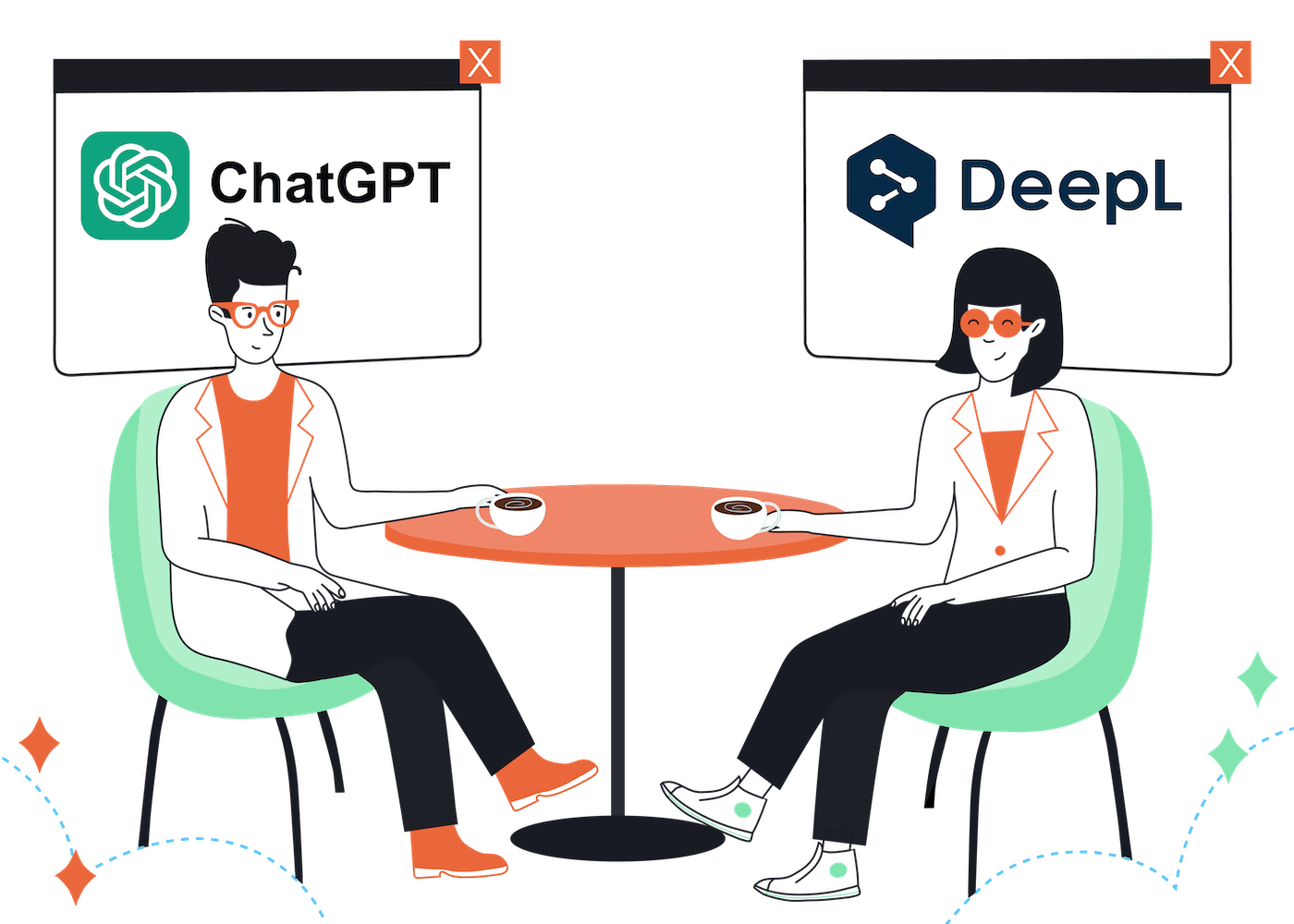As someone who’s always been fascinated by the power of language, I’ve been actively using both DeepL and ChatGPT for different aspects of my work at Tooltester. As a native German speaker, I often find myself in need of accurate English to German translations when translating smaller articles, for example.
After having used Google Translate for years, I was truly impressed the first time I used DeepL, which produces AI-based translations that just sound much better than Google’s. DeepL currently supports 29 languages.
However, when ChatGPT entered the ring, I didn’t only use it to help me build websites, but also for translations. And the results were impressive too! Another big advantage of ChatGPT is that it supports many more languages (According to ChatGPT itself, it supports 66 languages with a proficiency of at least 4 out of 5).
This got me thinking: which one of these two does a better job at it?
For my test, I translated four different pieces of text from English to German and Spanish, first with ChatGPT 4.0, then with DeepL. And I even let ChatGPT 4.0 proofread DeepL’s texts to see if there were any improvements.
I am sure you’ll find the results pretty interesting!
Testing methodology
We’re using ChatGPT 4.0, which is the paid version. For DeepL, we’re using the free version. While this might seem a little unfair at first glance, it’s important to note that there’s no difference in translation quality between DeepL Free and Pro.
Our testing involves four different rounds, each with distinct types of text. For the German translations, I am the judge. Meanwhile, for the Spanish translations, they are reviewed by Asiea, one of our team’s native Spanish speakers.
ChatGPT vs DeepL for translations: Results
| Round | Winner |
|---|---|
| Round 1: Website text – German | DeepL |
| Round 2: News article – German | DeepL |
| Round 3: Video script – German | ChatGPT |
| Round 4: Support email – German | ChatGPT |
| Round 1: Website text – Spanish | ChatGPT |
| Round 2: News article – Spanish | ChatGPT |
| Round 3: Video script – Spanish | ChatGPT |
| Round 4: Support email – Spanish | ChatGPT |
| Jump to the conclusion | |
Read on, to understand what ChatGPT did better and why you shouldn’t write DeepL off too quickly.
German translations of different types of text
If you’ve ever studied German, you’ll know that it’s a notoriously difficult language to master. Given that DeepL is a German company, we have high expectations for its performance.
I’ll begin with a website text about logo designs, sourced from our own website. First, I translate it using ChatGPT, then with DeepL. Afterward, we provide ChatGPT with DeepL’s translation to let it proofread. We aim to see whether this approach improves the translations—or, conversely, makes them worse.
Round 1: Website Text from Tooltester.com: Original (74 words)
“There is perhaps no greater indicator of your brand’s identity than its logo. Simplistic, symbolic, and memorable—your logo is the critical first impression made on an audience. As the public face of your brand and values, your logo must evoke everything there is to say about who you are, what you offer, and to whom you serve—and it must do it all in a manner that is unmistakable and instantly recognized in its message.”
Translation with ChatGPT (71 words)
“Es gibt vielleicht keinen größeren Indikator für die Identität Ihrer Marke als Ihr Logo. Einfach, symbolisch und einprägsam – Ihr Logo ist der entscheidende erste Eindruck, der beim Publikum hinterlassen wird. Als öffentliche Repräsentation Ihrer Marke und Werte muss Ihr Logo alles vermitteln, was es über Sie zu sagen gibt, was Sie anbieten und wem Sie dienen – und das alles auf eine Weise, die unverkennbar und sofort in ihrer Botschaft erkannt wird.”
Translation with DeepL (74 words)
“Es gibt vielleicht keinen besseren Indikator für die Identität Ihrer Marke als ihr Logo. Einfach, symbolisch und einprägsam – Ihr Logo ist der entscheidende erste Eindruck, den Ihr Publikum gewinnt. Als öffentliches Gesicht Ihrer Marke und Ihrer Werte muss Ihr Logo alles aussagen, was es darüber zu sagen gibt, wer Sie sind, was Sie anbieten und wem Sie dienen – und das alles auf eine Weise, die unverwechselbar ist und in ihrer Botschaft sofort erkannt wird.”
DeepL proofread by ChatGPT (73 words)
“Kaum ein anderer Indikator spiegelt die Identität Ihrer Marke besser wider als Ihr Logo. Einfach, symbolisch und einprägsam; Ihr Logo ist der entscheidende erste Eindruck, den Ihr Publikum gewinnt. Als öffentliches Gesicht Ihrer Marke und Ihrer Werte muss Ihr Logo alles aussagen, was es darüber zu sagen gibt, wer Sie sind, was Sie anbieten und wem Sie dienen – und zwar auf eine Weise, die unverwechselbar ist und in ihrer Botschaft sofort erkannt wird.”
Result Round 1: German Website Text
DeepL wins this round as its translation uses more natural language. The version that was proofread by ChatGPT is similar, perhaps with a slight improvement.
A human translator would likely have shortened the last sentence, which becomes extremely long in German. Otherwise, the quality of the translation approaches that of human-level expertise.
Round 2: News article from Guardian.com: Original (55 words)
Lets see how our translation tools cope with newspaper articles:
“Although you’d never guess it from mainstream media, the most significant antitrust case in more than 20 years is under way in Washington. In it, the US justice department, alongside the attorneys general of eight states, is suing Google for abusively monopolising digital advertising technologies, thereby subverting competition through “serial acquisitions” and anti-competitive auction manipulation.”
Translation with ChatGPT (48 words)
“Obwohl man es den Mainstream-Medien nie ansehen würde, läuft in Washington der bedeutendste Kartellrechtsfall seit mehr als 20 Jahren. Darin verklagt das US-Justizministerium zusammen mit den Generalstaatsanwälten von acht Bundesstaaten Google wegen missbräuchlicher Monopolisierung digitaler Werbetechnologien und damit einhergehender Untergrabung des Wettbewerbs durch „serielle Übernahmen“ und wettbewerbswidrige Auktionsmanipulationen.”
Translation with DeepL (51 words)
“Auch wenn man es in den Mainstream-Medien nicht vermuten würde, ist in Washington der bedeutendste Kartellrechtsfall seit mehr als 20 Jahren im Gange. Darin verklagt das US-Justizministerium zusammen mit den Generalstaatsanwälten von acht Bundesstaaten Google wegen missbräuchlicher Monopolisierung digitaler Werbetechnologien und damit Untergrabung des Wettbewerbs durch “serielle Übernahmen” und wettbewerbswidrige Auktionsmanipulation.”
DeepL proofread by ChatGPT (49 words)
“Obwohl es in den Mainstream-Medien nicht offensichtlich ist, ist in Washington der bedeutendste Kartellrechtsfall seit mehr als 20 Jahren im Gange. Darin verklagt das US-Justizministerium zusammen mit den Generalstaatsanwälten von acht Bundesstaaten, Google wegen missbräuchlicher Monopolisierung digitaler Werbetechnologien und damit Untergrabung des Wettbewerbs durch “serielle Übernahmen”, und wettbewerbswidrige Auktionsmanipulation.”
Results Round 2: News article from Guardian
DeepL performs better in this round as well. The text translated by DeepL, and subsequently revised by ChatGPT, was of similar quality but slightly shorter. As in the first round, there’s an extremely long sentence that a skilled human translator would likely have shortened.
Round 3: Video script from Tooltester (88 words)
In round 3 we’re looking at a video script from one of our YouTube videos.
“Hey Lissette here for Tooltester. Are you looking to improve the deliverability of your emails, to make sure they don’t end up in spam?
Well, in this video, we’ll give you a few quick tips to increase your chances of landing your marketing emails in subscribers’ inboxes so that they actually get seen. Our first tip is to authenticate your email, which is also the most technical of our suggestions. In a nutshell, this is to prove that you are who you say you are in your emails.“
Translation with ChatGPT (85 words)
“Hallo, hier ist Lissette für Tooltester. Möchten Sie die Zustellbarkeit Ihrer E-Mails verbessern, um sicherzustellen, dass sie nicht im Spam landen?
Nun, in diesem Video geben wir Ihnen einige schnelle Tipps, um Ihre Chancen zu erhöhen, dass Ihre Marketing-E-Mails in den Posteingängen der Abonnenten landen, damit sie tatsächlich gesehen werden. Unser erster Tipp ist, Ihre E-Mail zu authentifizieren, was auch der technischste unserer Vorschläge ist. Kurz gesagt, es geht darum zu beweisen, dass Sie in Ihren E-Mails die Person sind, für die Sie sich ausgeben.”
Translation with DeepL (83 words)
“Hallo Lissette hier für Tooltester. Möchten Sie die Zustellbarkeit Ihrer E-Mails verbessern, um sicherzustellen, dass sie nicht im Spam landen?
In diesem Video geben wir Ihnen ein paar schnelle Tipps, wie Sie die Chancen erhöhen können, dass Ihre Marketing-E-Mails in den Posteingängen der Abonnenten landen und tatsächlich gesehen werden. Unser erster Tipp ist die Authentifizierung Ihrer E-Mail, die auch der technischste unserer Vorschläge ist. Kurz gesagt geht es darum, zu beweisen, dass Sie derjenige sind, der Sie in Ihren E-Mails zu sein vorgeben.”
DeepL proofread by ChatGPT (85 words)
“Hallo, Lissette hier für Tooltester. Möchten Sie die Zustellungsrate Ihrer E-Mails verbessern, um sicherzustellen, dass sie nicht im Spam landen?
In diesem Video geben wir Ihnen einige schnelle Tipps, wie Sie die Chancen erhöhen können, dass Ihre Marketing-E-Mails in den Posteingängen der Abonnenten landen und tatsächlich gesehen werden. Unser erster Tipp ist die Authentifizierung Ihrer E-Mail-Adresse, die auch der technischste unserer Vorschläge ist. Kurz gesagt, geht es darum, zu beweisen, dass Sie derjenige sind, der Sie in Ihren E-Mails zu sein vorgeben.”
Results Round 3: Video script from Tooltester
ChatGPT wins this round because DeepL made a grammar mistake—it chose the wrong pronoun, using “die” instead of the correct “der” or even better “welcher”. Interestingly, ChatGPT didn’t correct this mistake in the proofread version either.
Round 4: Support email (54 words)
In our final round, we are checking how good our translation tools deal with personal emails:
“Hi Oscar, thank you for your comment. Yes, in order to publish a website using your own domain name, you need to purchase a paid monthly or yearly subscription with Wix. They do offer you the option to publish a site for free, but you won’t be able to use your own domain name.”
Translation with ChatGPT (47 words)
“Hallo Oscar, danke für deinen Kommentar. Ja, um eine Website mit deinem eigenen Domain-Namen zu veröffentlichen, musst du ein kostenpflichtiges monatliches oder jährliches Abonnement bei Wix erwerben. Sie bieten dir zwar die Möglichkeit, eine Website kostenlos zu veröffentlichen, aber du wirst deinen eigenen Domain-Namen nicht verwenden können.”
Translation with DeepL (47 words)
“Hallo Oscar, vielen Dank für deinen Kommentar. Ja, um eine Website mit Ihrem eigenen Domainnamen zu veröffentlichen, müssen Sie bei Wix ein kostenpflichtiges Monats- oder Jahresabonnement abschließen. Wix bietet Ihnen zwar die Möglichkeit, eine Website kostenlos zu veröffentlichen, aber Sie können dann nicht Ihren eigenen Domainnamen verwenden.”
DeepL proofread by ChatGPT (46 words)
“Hallo Oscar, vielen Dank für deinen Kommentar. Ja, um eine Website mit deinem eigenen Domainnamen zu veröffentlichen, müssen Sie bei Wix ein kostenpflichtiges Monats- oder Jahresabonnement abschließen. Wix bietet zwar die Möglichkeit, eine Website kostenlos zu veröffentlichen, aber Sie können dann nicht Ihren eigenen Domainnamen verwenden.”
Results Round 4: Support email
It’s a clear win for ChatGPT again, as DeepL got the personal pronouns wrong. It started with the informal “dein” and then switched to the formal “Ihnen.” Switching from informal to formal is jarring and signals to the reader that it’s a machine translation.
Interestingly, ChatGPT only caught one of DeepL’s errors when proofreading, leaving the other two in the text. Unfortunately, you can’t rely on ChatGPT’s proofreading abilities right out of the box (see ‘ChatGPT protip’ further down below).
German translations: Conclusion
I liked DeepL’s style better overall – that’s also why it won the first two rounds. But if you want to stay on the safe side regarding grammar, you’re better off using ChatGPT 4.0. The language is a bit more clunky, but at least everything is correct.
Another advantage is that you can give ChatGPT the full context of your conversation, leading to even better results.
Spanish translations of different types of text
I speak Spanish, but not fluent enough to be a reliable judge of translation quality. That’s why I asked our Spanish office manager, Asiea, to help me evaluate the translations in the following tests.
Round 1: Website Text from Tooltester.com: Original (74 words)
“There is perhaps no greater indicator of your brand’s identity than its logo. Simplistic, symbolic, and memorable—your logo is the critical first impression made on an audience. As the public face of your brand and values, your logo must evoke everything there is to say about who you are, what you offer, and to whom you serve—and it must do it all in a manner that is unmistakable and instantly recognized in its message.”
Translation with ChatGPT (75 words)
“Quizás no haya un indicador más grande de la identidad de tu marca que su logotipo. Sencillo, simbólico y memorable—tu logotipo es la primera impresión crítica que se hace en una audiencia. Como la cara pública de tu marca y valores, tu logotipo debe evocar todo lo que hay que decir sobre quién eres, qué ofreces y a quién sirves—y debe hacerlo todo de una manera que sea inconfundible y reconocida instantáneamente en su mensaje.”
Translation with DeepL (74 words)
“Quizá no haya mayor indicador de la identidad de su marca que su logotipo. Simplista, simbólico y memorable, el logotipo es la primera impresión que se causa al público. Como cara pública de su marca y sus valores, su logotipo debe evocar todo lo que hay que decir sobre quién es usted, qué ofrece y a quién sirve, y debe hacerlo de una manera que sea inconfundible y reconocible al instante en su mensaje.”
DeepL proofread by ChatGPT (66 words)
“Quizá no haya mayor indicador de la identidad de su marca que su logotipo. Sencillo, simbólico y memorable, el logotipo proporciona la primera impresión al público. Como cara pública de su marca y sus valores, su logotipo debe evocar todo lo que representa, lo que ofrece y a quién sirve, y debe hacerlo de una manera que sea inconfundible y reconocible al instante en su mensaje.”
Result Round 1: Spanish Website Text
ChatGPT wins this round. DeepL went a little overboard with commas and made the sentence too long. DeepL’s results were improved by ChatGPT’s proofreading, which removed 8 words.
Round 2: News article from Guardian.com: Original (55 words)
“Although you’d never guess it from mainstream media, the most significant antitrust case in more than 20 years is under way in Washington. In it, the US justice department, alongside the attorneys general of eight states, is suing Google for abusively monopolising digital advertising technologies, thereby subverting competition through “serial acquisitions” and anti-competitive auction manipulation.”
Spanish ChatGPT translation (71 words)
“Aunque nunca lo adivinarías a través de los medios de comunicación convencionales, el caso antimonopolio más significativo en más de 20 años está en curso en Washington. En él, el Departamento de Justicia de los EE.UU., junto con los fiscales generales de ocho estados, está demandando a Google por monopolizar abusivamente las tecnologías de publicidad digital, subvirtiendo así la competencia a través de “adquisiciones seriales” y manipulación anti-competitiva de subastas.”
DeepL translation (67 words)
“Aunque los principales medios de comunicación nunca lo dirían, el caso antimonopolio más importante en más de 20 años está en marcha en Washington. En él, el Departamento de Justicia de Estados Unidos, junto con los fiscales generales de ocho estados, demanda a Google por monopolio abusivo de las tecnologías de publicidad digital, subvirtiendo así la competencia mediante “adquisiciones en serie” y manipulación anticompetitiva de las subastas.”
DeepL translation proofread by ChatGPT (67 words)
“Aunque los principales medios de comunicación nunca lo dirían, está en marcha en Washington el caso antimonopolio más importante en más de 20 años. En él, el Departamento de Justicia de Estados Unidos, junto con los fiscales generales de ocho estados, demanda a Google por su monopolio abusivo en las tecnologías de publicidad digital, socavando así la competencia mediante “adquisiciones sucesivas” y manipulación anticompetitiva de las subastas.”
Results Round 2: News article from Guardian
Again, ChatGPT wins due to its overall better text quality. Although neither text contains grammatical mistakes, ChatGPT performed better in stylistic execution.
Round 3: Translating a video script (88 words)
“Hey Lissette here for Tooltester. Are you looking to improve the deliverability of your emails, to make sure they don’t end up in spam?
Well, in this video, we’ll give you a few quick tips to increase your chances of landing your marketing emails in subscribers’ inboxes so that they actually get seen. Our first tip is to authenticate your email, which is also the most technical of our suggestions. In a nutshell, this is to prove that you are who you say you are in your emails.”
Translation with ChatGPT (88 words)
“Hola, Lissette aquí para Tooltester. ¿Estás buscando mejorar la entregabilidad de tus correos electrónicos, para asegurarte de que no terminen en spam?
Bueno, en este video, te daremos algunos consejos rápidos para aumentar tus posibilidades de que tus correos electrónicos de marketing lleguen a las bandejas de entrada de los suscriptores y así realmente sean vistos. Nuestro primer consejo es autenticar tu correo electrónico, que también es la sugerencia más técnica de todas. En resumen, esto es para demostrar que eres quien dices ser en tus correos electrónicos.”
Translation with DeepL (88 words)
“Hola Lissette aquí para Tooltester. ¿Quieres mejorar la entregabilidad de tus correos electrónicos para asegurarte de que no acaban en el spam?
Bueno, en este video, te daremos algunos consejos rápidos para aumentar tus posibilidades de aterrizar tus correos electrónicos de marketing en las bandejas de entrada de los suscriptores para que realmente sean vistos. Nuestro primer consejo es autenticar tu correo electrónico, que es también la más técnica de nuestras sugerencias. En pocas palabras, se trata de demostrar que eres quien dices ser en tus correos electrónicos.”
DeepL translation proofread by ChatGPT (90 words)
“Hola, soy Lissette de Tooltester. ¿Quieres mejorar la entregabilidad de tus correos electrónicos para asegurarte de que no acaben en la carpeta de spam? Bueno, en este video, te daremos algunos consejos rápidos para aumentar tus posibilidades de que tus correos electrónicos lleguen a las bandejas de entrada de tus suscriptores para que realmente sean vistos. Nuestro primer consejo es autenticar tu correo electrónico, lo cual es también la sugerencia más técnica de todas. En pocas palabras, se trata de demostrar que eres quien dices ser en tus correos electrónicos.”
Results Round 3: Video script from Tooltester
Once again, ChatGPT wins. However, this time a human translator would likely have done a much better job. For example, a human would have opted for “email” instead of repeatedly using the bulkier term “correo electrónico.” This choice would improve the text’s flow, especially since “email” is a term well-known in Spanish-speaking countries.
This time, the ChatGPT proofreading improved the DeepL text slightly.
Round 4: Support email (54 words)
“Hi Oscar, thank you for your comment. Yes, in order to publish a website using your own domain name, you need to purchase a paid monthly or yearly subscription with Wix. They do offer you the option to publish a site for free, but you won’t be able to use your own domain name.”
Translation from ChatGPT (49 words)
“Hola Oscar, gracias por tu comentario. Sí, para publicar un sitio web utilizando tu propio nombre de dominio, necesitas comprar una suscripción pagada mensual o anual con Wix. Ellos te ofrecen la opción de publicar un sitio de forma gratuita, pero no podrás utilizar tu propio nombre de dominio.”
Translation from DeepL (49 words)
“Hola Oscar, gracias por tu comentario. Sí, para publicar un sitio web utilizando tu propio nombre de dominio, necesitas adquirir una suscripción mensual o anual de pago con Wix. Te ofrecen la opción de publicar un sitio de forma gratuita, pero no podrás utilizar tu propio nombre de dominio.”
DeepL translation proofread by ChatGPT (51 words)
“Hola Oscar, gracias por tu comentario. Sí, para publicar un sitio web utilizando tu propio nombre de dominio, necesitas adquirir una suscripción mensual o anual de pago ofrecida por Wix. Wix te ofrece la opción de publicar un sitio de forma gratuita, pero no podrás utilizar tu propio nombre de dominio.”
Results Round 4: Support email
This was the easiest translation task for our AI tools. Once again, ChatGPT performed the best, although DeepL was very close. For this round, a human translator likely wouldn’t have made a significant difference compared to the machine translations.
If you’re using the paid version of ChatGPT, you can add Custom Instructions. I’ve found it effective to include “When translating and proofreading, always double-check the grammar” as my guideline for how I want ChatGPT to respond. This approach even eliminated the grammatical errors that DeepL introduced in some of the German texts.
Conclusion ChatGPT vs DeepL
So, what should you use for your translations?
In the past, I frequently used DeepL for languages I’m not fluent in, and then had ChatGPT proofread the translations. I primarily employed this approach for support emails and responding to comments.
However, I’m considering a change. Our Spanish test rounds clearly suggest that ChatGPT performs better overall.
But if you aren’t fully proficient in the language to which you are translating, keep in mind that machine translation will still lack a bit of that human touch. Sentences can sometimes be very long and may not be as polished as a good human translation could be. Fortunately, we are working with extremely talented human translators who can easily add that human touch, helping our articles stand out.
For smaller German translations, however, I plan to stick with DeepL and do my own proofreading. I prefer DeepL’s style, although the occasional grammatical mistakes are a concern. For those who aren’t native German speakers, it’s safer to use ChatGPT, even if the style isn’t as polished.
A significant advantage of ChatGPT, as mentioned earlier, is the ability to request changes and provide context. This is particularly effective if you have some familiarity with the language you’re translating.
DeepL, on the other hand, excels at translating large volumes of text quickly, with just the click of a button, while ChatGPT takes its time.
So, what’s your choice for translations? Share your thoughts in the comments!
FAQ
According to ChatGPT itself, it supports more than 200 languages. However, when asked to rate its own proficiency on a scale of 1 to 5, it provided a list of 66 languages for which it gave itself a rating of at least 4.
Here are the 14 languages that received a maximum proficiency rating of 5:
- English
- Spanish
- French
- German
- Chinese (Simplified and Traditional)
- Russian
- Italian
- Dutch
- Portuguese
- Japanese
- Korean
- Arabic
- Hindi
- Urdu
And these are the rest of the languages where ChatGPT rated itself a proficiency level of 4:
- Greek
- Turkish
- Hebrew
- Czech
- Polish
- Romanian
- Hungarian
- Thai
- Ukrainian
- Indonesian
- Vietnamese
- Filipino
- Malay
- Bengali
- Gujarati
- Marathi
- Punjabi
- Telugu
- Tamil
- Kannada
- Malayalam
- Swahili
- Afrikaans
- Icelandic
- Slovak
- Slovenian
- Serbian
- Croatian
- Bosnian
- Bulgarian
- Macedonian
- Albanian
- Estonian
- Latvian
- Lithuanian
- Belarusian
- Georgian
- Armenian
- Azerbaijani
- Kazakh
- Uzbek
- Tajik
- Pashto
- Farsi (Persian)
- Dari
- Nepali
- Sinhalese
- Maltese
- Basque
- Galician
- Esperanto
- Catalan
We keep our content up to date
18 Oct 2023 – Information added on the number of languages DeepL and ChatGPT support
06 Oct 2023 – Small stylistic changes
THE BEHIND THE SCENES OF THIS BLOG
This article has been written and researched following a precise methodology.
Our methodology


